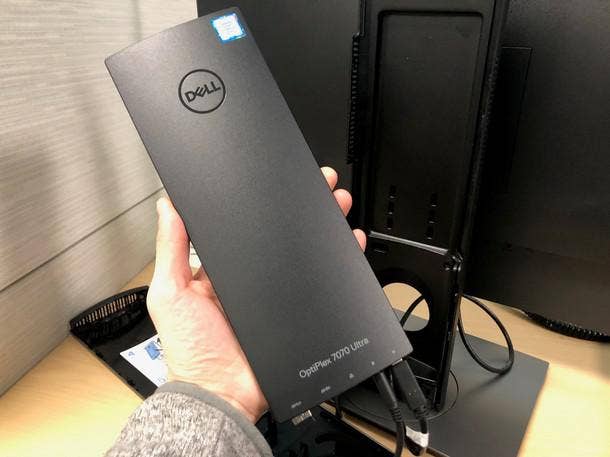Review: Dell's OptiPlex 7070 Ultra Makes Case For A More-Upgradeable PC Future
The CRN Test Center finds that the unique modular approach with the Dell PC could prove useful to many businesses.

The market for desktop PCs certainly is not what it once was—but that doesn't mean there's no further need for innovation.
For businesses that still rely on desktops for their workforce, the concept of an ultra-small-form-factor modular PC has been taking off in recent years as one way to improve on the traditional desktop approach. With the OptiPlex 7070 Ultra, Dell is looking to take the concept much further, and we think the results are commendable even though there’s room for further advances in a few areas.
[Related: HP, Dell, Lenovo Recapture PC Growth Amid Windows 7 End-Of-Life]
The OptiPlex 7070 Ultra offers a form factor that is small enough to fit entirely inside the back of a monitor, essentially offering a zero-footprint desktop PC design. The PC measures just 0.78 of an inch thick with a width of 3.8 inches and a height of 10 inches—for a total volume of only 26.6 cubic inches.
That small size enables the desktop to disappear into the back of a display stand—which in our tryout is Dell's 27-inch P2719HC—providing the aesthetics of an all-in-one. The PC unit itself also weighs just 1.4 pounds.
And there's no sacrifice on performance even with the compact form factor: The PC enabled speedy computing in our tryout thanks to a quad-core Intel Whiskey Lake Core i7 (the i7-8665U) and 16 GB of RAM. The i7-8665U and one other available processor for the Ultra, the Core i5-8365U, also include Intel vPro technology.
We consider the serviceability and upgradeability to be the strongest features of the PC. Because the Ultra can be easily removed, it can be swapped out, upgraded or serviced as needs arise for the user. And doing so does not require tools, making the process even quicker for the IT team.
We found the Ultra to be relatively easy to install into the display stand, although it did take a bit of fiddling to make sure that the PC was oriented the right way and that the power and DisplayPort cables were run through the stand correctly.
It’s worth emphasizing that even though the OptiPlex 7070 Ultra and display "look" like an all-in-one to the end user, you still need to have two power cables set up—one for the PC and one for the display. As mentioned, you also still need to connect a DisplayPort cable from the PC (enclosed in the stand) to the monitor screen. If there's one area we'd love to see simplified in future updates, it would be the cabling setup. (Though certainly, once an IT team learned how to set up the machine, we're sure it would go much faster.)
Access to some of the ports is also a bit awkward, since several are located on the Ultra unit that is inside the display stand. The 3.5mm headphone jack, in particular, is probably not where you would ideally place it on an all-in-one.
All of that being said, we applaud Dell for bringing a strong first offering to this novel PC category with the OptiPlex 7070 Ultra. The concept could certainly be the wave of the future for business desktops, with businesses perennially interested in the sort of deployment, serviceability and space-saving capabilities that the OptiPlex 7070 Ultra offers.
Dell's OptiPlex 7070 Ultra has a starting price of $769.79, or $1,618 as configured for our review (with the P2719HC display).